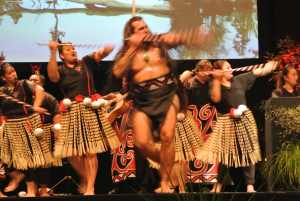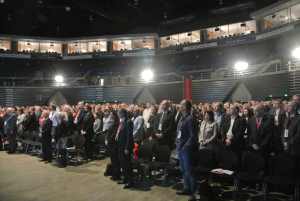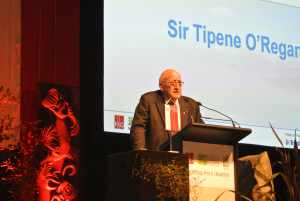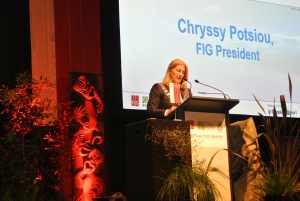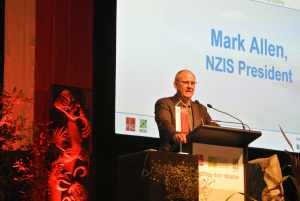News in 2016

|
FIG Working Week 2016 – Recovery from Disaster – recovery from a large
success
2-6 May 2016, Christchurch, New Zealand
We are now - not recovering from disaster - but from a large and
different Working Week success!
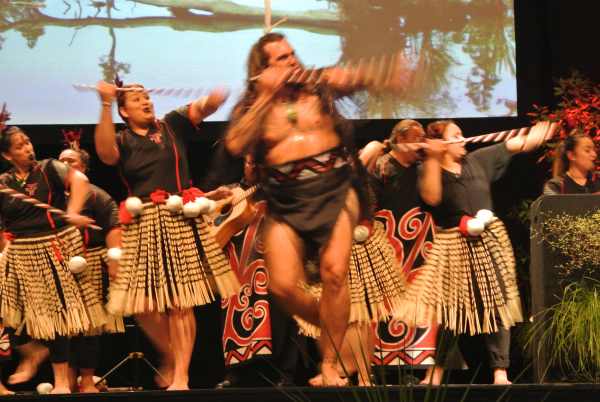
Traditional Maori Welcome Dance
The theme of this years FIG Working Week met the eye from the very
beginning. Already at the arrival in Christchurch, New Zealand, the
damages caused by the severe earthquakes that took place in 2011-12 in
the Canterbury region followed by liquefaction that also did a lot of
damage, were visible. The city was full of parking lots filled with
rubble clearly showing the many empty spots where houses have been
before the earthquakes.
The venue also reminded all the participants that this was not a
“normal” FIG Working Week. The conference had to be relocated to a
Sports Arena. The Conference Center of the city had not survived the
earthquakes, and although there were early plans to rebuild the centre,
it was soon clear for the Local Organisers and FIG that it would be too
risky to rely on a new conference centre by 2016. Good for that – the
building has not yet been started…
The Sports Arena included a Rugby Stadium – and there was a
possibility to buy tickets for a rugby game with the local heroes, The
Crusaders, after the Working Week; a Horse Racing Course, which building
was used for the technical sessions; and finally a large multi arena
that was used for both the plenary sessions and the exhibition. Here
lunches and tea/coffee was also served. The Addington Raceway Building
included the exotic session room names Blossom Lady, Terror of Love,
Christian Cullen and Silk named after famous race horses.
More than 800 participants had found their way to the Working Week in
Christchurch from 73 countries, and around 250 papers were presented in 86 sessions during
the three conference days. Of these 86 sessions 23 were special
sessions, hereunder sessions in cooperation with the institutional
partners FAO, UN-Habitat-GLTN and the World Bank and sessions with
specific themes. 28 peer review papers had passed the thorough peer
review process out of originally 86 submitted papers. A very big thanks
to the faithful FIG reviewers and the main editor Volker Schwieger.
Hereto a number of pre-workshops were held: on the Small Island
development(SIDS) in cooperation with UN-Habitat/GLTN, NZ-Aid and FAO,
Reference Frame in Praxis organised by FIG Commission 5 in cooperation
with UNOOSA, Young Surveyors conference, STDM training course, and a
symposium on History of Surveying. The Young Surveyors had organised a
Charity Run/Walk at Hagley Park having around 80 young – and older –
surveyors run/walk a 2.5 or 5 km distance. This was a big success,
especially for those who had been inside in meetings and workshops all
day, and a very different event. The Charity Run was supported by
Trimble and Ripro Corporation from Japan and supported MapAction and FIG
Foundation.
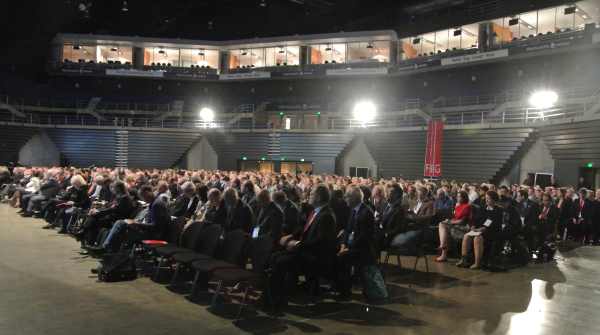
The Plenary Hall was full at the opening and the Plenary sessions
Opening Ceremony
At the Opening Ceremony all participants were greeted festively in
the traditional Maori way, followed by an address by Sir Tipene O’Regan,
who has been commemorated as one of the Twelve Local Heroes of
Christchurch. He spoke over the importance of “Identity, names and
places” and explained why it is important for Maoris to identify where a
person is from.
The key note speaker of the Working Week was Margareta Wahlstrom who
has been the UN Special Representative of the Secretary General for
Disaster Risk Reduction until the end of 2015. Margareta Wahlstrom
underlined that disaster is a social issue as well as of economic – what
are the immediate costs, but also what are the costs in 5-10 years.
There is a special focus right after a disaster, but a focus on the
longer run is also important. She furthermore challenged the surveyors
stating that “we need people to reach out to decisions makers on the
work on disasters” and “disasters are a political issue”. Hereto she
encouraged surveyors to be more visible, and to promote themselves and
the work that surveyors do much more than is the case today. She
followed up on the welcome address of FIG President Chryssy Potsiou, and
encouraged surveyors to be visible within the areas land use planning
and urban planning. “No other than surveyors know about this. We must be
more precise – globally, but especially locally and nationally”.
Collecting data and systemising it takes a long time but is important.
She finally said that today, risk assessment is not counted into many
strategies of companies in the private sector, nor is risk perception.
The Sendai framework has managed to define disasters in a modern and
updated version, and is focusing on not only what is good for us but
what we should do at a national, regional and global level. “Build back
better – from the start” is a key word – and surveyors play a great role
in this.
Mark Allen, President of New Zealand Institute of Surveyors, NZIS,
the local host and FIG President Chryssy Potsiou welcomed all
participants to this Working Week in New Zealand. In her
opening address, President Potsiou stated that “FIG will move
toward more holistic, multi-sector partnerships to more systematically
address the global challenges, including dealing with disasters and
achieving secure land rights for all by 2030. FIG has developed a close
relationship with United Nations Agencies, the World Bank, the European
Union and other important international institutions. It is important
that FIG build on these relationships. It is important for FIG to lend
its collective expertise to all aspects of disaster management for the
betterment of societies everywhere. It is also important that FIG be
directly involved in these activities for the growth and vitality of its
members and their activities in this era of Globalization. FIG strongly
believes in the power of joint research with the UN and the World Bank,
in advising people and partners on making smart, evidence-based
solutions that shape the development agenda. FIG, its member
associations, academic members, affiliate members, corporate members,
its commissions, task forces and networks, will coordinate more of what
we do so that we are more strategic in our collective actions and ensure
that priority goes to activities with the highest returns. We will also
do more to build on new technologies; create new opportunities for
surveyors; and capitalize on more affordable high-resolution spatial
data”.
Plenary sessions
The plenary sessions covered disasters from various angles, and
disasters were also a theme at many of the technical sessions including
all the areas of surveying. The first plenary session was dedicated the
“Christchurch Story” which was told by the Mayor of Christchurch, Hon.
Lianne Dalziel, the Associate Minister supporting Greater Christchurch
Regeneration, Hon Nicky Wagner and Mr. Duncan Gibb Founding General
Manager of SCIRT (Stronger Christchurch Infrastructure Rebuild Team).
The “Christchurch Story” was followed by some very strong and impressive
photos from immediately after the earthquakes and the rebuilding process
on the longer run. These photos more or less talked for themselves. The
presenters pointed out that a large amount was paid out in the first
week after the earthquakes in order to keep people alive, and that
“we should have been better prepared if we had learned from the earlier
experience”. One vital focus was to get business up and running as
fast as possible so that a “normal” life could be somehow maintained,
and to show the inhabitants of the area that “we are here to help
you”; e.g. establishing free legal advise. It was furthermore
stated that “it is all about people” pointing out that you
cannot communicate too much in such a crisis situation and finally that
“hope is not a method”.
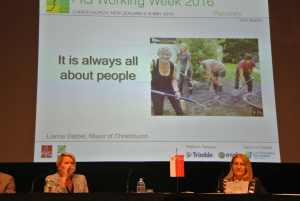
During her presentation, Hon Lianne Dalziel, Mayor of Christchurch, showed the audience how she and the inhabitants of Christchurch all helped out right
after the earthquakes
|
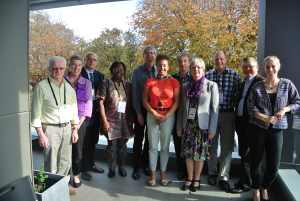
FIG Commission Chairs incl Young Surveyors network was having their annual meeting during the Working Week. From left: Brian Coutts com 1, Liza Groenedjik com 2
|
Enrico Rispoli com 3, Angela Etuonovbe com 4, Volker Schwieger com 5, Vice President Diane Dumashie, council responsible for the commissions, Ivo Milev com 6, Gerda Schennach com 7, Steven Nystrom com 9, See Lian Ong com 10 and Eva-Maria Unger Young Surveyors Network (Kwame Tenadu com 8 was unfortunately not present)
The first speaker in the second plenary session Dr. Hiroshi Murakami
almost did not make it to the Working Week because Japan was hit by
earthquakes just three weeks before the Working Week and his help was
needed. Luckily he still managed to come, and could give the
participants another real-life insight in a disaster area. He pointed
out that improvements are needed to prepare for future catastrophes,
hereunder to have updated maps of areas that can help to compare the
situation before and after a disaster. Gregory Scott, leader of the
secretariat for the United Nations Committee of Experts on Global
Geospatial Information Management (UN-GGIM), presented the global
perspective with impressive statistics on disaster loss – both in terms
of numbers of affected people (more than 1.5 billion) and in money (more
than one trillion dollars). The Post-2015 Development Agenda is
actionable, and data about people and place is an indispensable element
in this agenda.
Keith Bell, World Bank, stated that 80% loss of people in connection
with disasters come from low income countries. The complexity for these
countries is much larger than in the developed world. The best situation
is of course to prepare for disasters, but after a disaster the key term
is “Build Back Better” – and one of the first examples of this took
place in Indonesia. The “Build Back Better” concept should be used to
rethink an area and not “just” build up what was there before. It is
important is to have reliable geospatial data – and the World Bank
recommends to get this on a Fit-for-Purpose basis that secures that
there will be data although it may not be fully detailed. Finally, Keith
Bell has already previously asked whether FIG can lead national
professional bodies to put surveyors on the pro bono humanitarian map,
and in his plenary speech he again took the opportunity to encourage
FIG. The network of the Young Surveyors is a good example of how this
can be started.
This line was followed at the third plenary session. The final
speaker was Sam Johnson. Sam is a shining example of youth leadership.
He was the leader of the Student Volunteer Army (SVA) in the aftermath
of the 22 February Christchurch earthquake and gave and inspirational
talk on harnessing students/youth in response to disaster situations.
The SVA tapped into a well of good will and enthusiasm to help people.
Their work is now part of Christchurch. Sam has now gone on to help
people in Nepal and his message is to question processes in a disaster
situation. His preferred method is to galvanise volunteers, what he
calls utilising the powerful skills of the unskilled. This is, he
argues, “perfect in its imperfection”. Sam also challenged FIG
and Member Associations to establish a network of young surveyor
volunteers to respond to disaster relief - Surveyors without Frontiers
Mark Nicholls (Trimble) stated that the profession is moving from
maps to models. He presented an impressive description of Trimble’s role
right after the earthquakes in Christchurch. Surveyors need to keep
their current skillsets but enhance them to become spatial data experts,
understanding and interpreting a plethora of data from several sources.
The challenge is to effectively manage spatial information from
everywhere including 1cm accurate data available for everyone. This
requires the Surveyor to
- Deliver the right information to the right people
- Manage all the spatial data during the life cycle of a
project
Professor Jixian Zhang gave a very impressive presentation on the use
of remote sensing and photogrammetry in disaster response in the Chinese
context. The Chinese Government has invested heavily in satellite based
remote sensing, photogrammetry, airborne mapping including unmanned
platforms/UAVs and mobile mapping system to respond to and mitigate
natural disasters in China Photogrammetry and remote sensing play an
important part of the National Disaster Action Plan, covering (in part)
- Analysis, monitoring, evaluation, warning and support for
recovery planning.
- Sub metre accurate data across the entire country.
- Rapid data processing and disaster information extraction to
enable disaster evaluation and early warning to the people in
potentially affected areas.
- Online video conferencing throughout China.
- Accurate mapping for post-disaster reconstruction planning
helping with the rapid rebuilding of devastated cities.
Future challenges to be overcome are:
- Improve data sharing
- Achieve multi sensor data assimilation
- Objective and accurate monitoring and evaluation
- Integrate new technology into disaster management
He challenged the audience to: Be quick, Be accurate, Be
effective.
Technical sessions and tours
The ten FIG Commissions, Young Surveyors, FIG Networks, Permanent
insititutions and Task Forces have been heavily involved in the planning
of the technical sessions that covered a broad range of themes within
surveying, and many with the overall theme “Recovery from Disaster” in
mind. The technical sessions were a mixture of presentations and
in-depth discussions. There were special sessions on the Voluntary
Guidelines organised together with FAO, a special session on Nepal
organised jointly by FIG Young Surveyors and UN-Habitat/GTLN on Nepal
Building Back Better in order to introduce challenges of building back
better initiatives in the post-earthquake situation in Nepal including
rehabilitating informal/non-formal settlers and risk hazard-prone
settlements, to present current efforts of building back better Nepal
and to explore the way forward based on international best
practices.Special sessions in cooperation with UN-Habitat/GLTN, a
special session elaborating on the pre-conference workshop on SIDS in
which a declaration was finalised, and a high level special session on
the Fit-for-Purpose approach launching a Fit-for-Purpose guide and many
more. See the
proceedings
for the full list of sessions, papers and
presentations.
Again in 2016, the FIG Platinum Corporate Members, Bentley, Esri,
Leica and Trimble were offered a session in the technical programme, and
they had all invested in a thorough planning of the sessions which were
all well visited.
The Local Organisers had made a great effort to organise some very
popular and informative technical tours e.g. showing the hands-on
rebuild situation in Christchurch, a visit to Land Information New
Zealand, the University of Canterbury, an earthquake-trip to Port Hills.
The Port Hills rock falls resulted in one of the largest rock fall
studies in the world. To determine the ongoing extent of land movement
multiple continually operating CGPS stations and crack monitoring points
were installed. Monitoring moved quickly from a basic string line
between 2 points, to state-of-the-art survey.
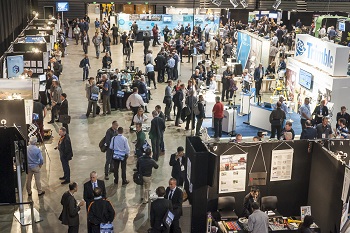
Exhibition
A well designed exhibition area met the participants at the tea
breaks and during lunches. The two platinum sponsors Esri and Trimble
were occupying the centre of the large multi arena. The Diamond Partner
LINZ together with the other exhibitors filled out the exhibition space
which was very crowded during the breaks. Wednesday afternoon the
exhibition opened for the public. Many talks with exhibitors continued
after the breaks and many took the opportunity to clear their head in
the exhibition area during a session.
Social Events
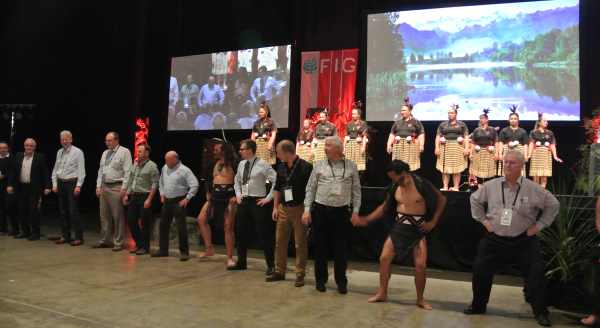
Maori male danse - and various international variations...
No Working Week without the possibility to network which is also an
important part of the event. The Welcome Reception took place at the
Transitional Cathedral, a new built cathedral building. The Transitional
Cathedral was built after the original Christchurch Cathedral was badly
damaged in the earthquake. The rest of the old cathedral is still
standing showing what large damages happened to many buildings. The room
was packed, the talk was loud and both reunions took place and new
acquaintances were formed.
The Kiwi Evening which is also a dinner in support of FIG Foundation
and supported by Trimble included a traditional Maori performance. At
this performance especially the male participants had the possibility to
find their inner male soul by shouting out loudly and practise their
dancing skills. The relaxed atmosphere – apart from the shouting – gave
a good opportunity to mingle and meet.
The Gala Dinner was held at the Air Force Museum of New Zealand. The
exhibition area was open and the dinner was held in the hangar and the
dinner tables were surrounded by all the airplanes. It was a very
special experience to sit among the old air planes enjoying a wonderful
dinner. A trio entertained with an enormous repertoire, and the dance
floor was filled up to the very end.
For the foreign participants it was also possible to register for a
home-hosting evening, where the hospitable New Zealanders opened their
homes for a nice and intimate dinner. This turned out to be a fun
evening for both the local and international participants.
The commission dinners were traditionally held on the second
conference day. Right before the dinner the commission meetings were
scheduled, so that it would be possible to go directly from the more
serious meeting to a nice get-together dinner in relaxed surroundings.
Some commissions joint forces and invited to a joint dinner whereas
other commissions organised their own dinners.
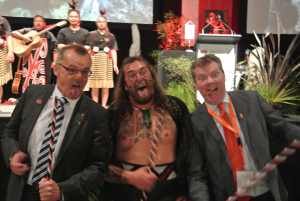
When do you get the chance to really shout out loud |

The female Maori dansers were an impressive sight
|

At the Gala Dinner surrounded by airplanes |
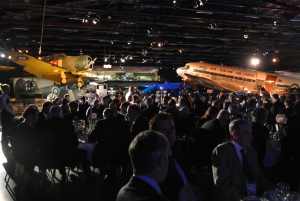
|
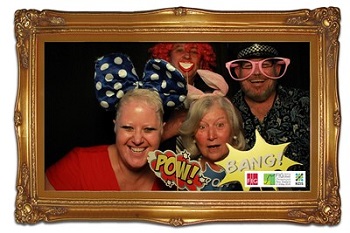 More
photos from photo booth |
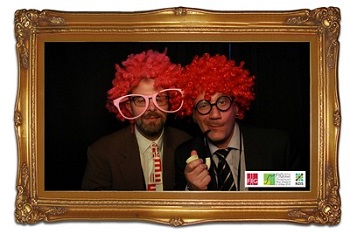
No comments... |
Closing Ceremony
At the closing ceremony FIG President Potsiou pointed out that
“humanity has lived with natural disasters for centuries but their
impact was not felt to the same extent in the past as is experienced
now: the more the people, the more the development, the greater the
loss. In surveyors’ understanding, good coordinates lead to good land
administration, insurance and compensation for better recovery”. She
thanked the participants for their active engagement in the many various
activities during the Working Week. The Local Organising Committee had
done an outstanding job to organise this very special event and had put
in a big effort to make everything run smoothly
.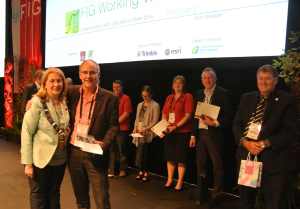
FIG President Potsiou thanks NZIS President Mark Allen, Co-Conference Director Simon Ironside and the successful team of local organisers
Links:
Louise Friis-Hansen
1 June 2016























